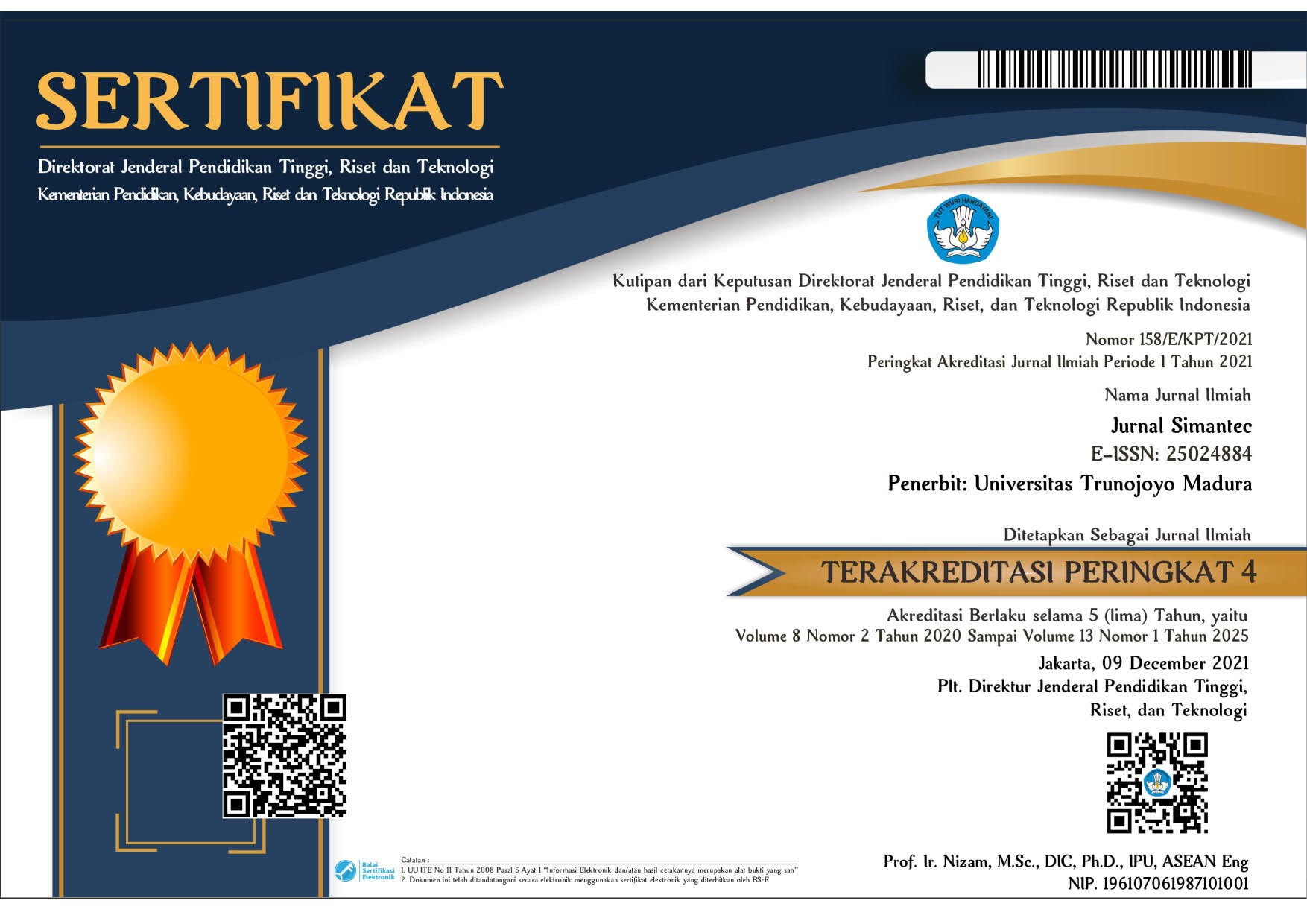PENINGKATAN PRODUKTIVITAS DENGAN IMPLEMENTASI METODE SIX SIGMA PADA PRODUK ELEMENT BOILER
Abstract
ABSTRAK
Produktivitas yang tinggi dalam menghasilkan komponen boiler dicapai dengan menggunakan sumber daya secara optimal. PT. XYZ dalam pelaksanaan proyek Unit 2 tidak mencapai peningkatan produktivitas yang diharapkan, karena tidak sesuai perencanaan kerja, dengan jumlah produk cacat berada diatas batas baku cacat. Metode Six Sigma dengan menggunakan siklus Define, Measure, Analyze, Improvement, dan Control (DMAIC) memberikan informasi peningkatan indeks produktivitas proyek Unit 2 terhadap proyek Unit 1 sebesar 2.98%. Terjadi penurunan Cost of Poor Quality (COPQ) dibandingkan proyek Unit 1 dengan proyek Unit 2 sebesar 3.79%. Perbedaan nilai mengindikasikan pengalokasian biaya kualitas Cost Of Achieving Good Quality(COGQ) dan COPQ kurang efektif dan efisien. Hasil waktu pengerjaan 4 minggu baseline kinerja dan kapabilitas Sigma data atribut produk Element Bending hasil DPMO sebesar 10.933,05 sehingga produk memiliki toleransi defect 10.933 unit per 1.000.000 unit produk. Variabel Thickness mempunyai rata-rata Defect per Million Opportunities (DPMO) untuk sample 19.453,33 maka memiliki toleransi defect 19.453 unit per 1.000.000 unit produk. Variabel Adhesiveness mempunyai rata-rata DPMO sample diambil sebesar 95.226,67 memiliki toleransi defect 95.227 unit per 1.000.000 unit produk dengan sigma level adalah 3,15.
Kata Kunci : Produktivitas, total, parsial, Six Sigma
Abstract
High productivity in producing boiler components is achieved by using resources optimally. PT. XYZ in project implementation Unit 2 did not achieve the expected increase in productivity, because it does not work according to plan, with the number of defective products is above the standard limit disability. Six Sigma methods using cycles Define, Measure, Analyze, Improvement, and Control (DMAIC) provides information increase productivity index Project Unit 2 to Unit 1amounted to 2.98%. Due to the reduced Cost of Poor Quality (COPQ) compared the project with project Unit 1 Unit 2 at 3.79%. The difference value indicates the allocation of the cost of quality Cost Of Achieving Good Quality (COGQ) and COPQ less effective and efficient. The results of processing time 4 week baseline performance and capabilities of the product attribute data Sigma Element Bending DPMO result of 10933.05 so that the product has a defect tolerance of 10 933 units per 1,000,000 product units.Variabel Thickness having an average Defect per Million Opportunities (DPMO) for sample 19453.33 then have a defect tolerance of 19 453 units per 1,000,000 units of the product. Adhesiveness variables had average DPMO sample taken at 95226.67 tolerance defect 95 227 units per 1,000,000 product units with sigma level is 3.15.
Keywords: Productivity, total, partial, Six Sigma.
Full Text:
PDF (Bahasa Indonesia)References
Steingress, F.M., Frost, H.J. and Walker, D. R. ,High Pressure Boilers, 3rd Edition, American Technical Publishers. 2003.
Gasperz,V, Manajemen Produktivitas Total, Strategi Peningkatan Produktivitas Bisnis Global, Gramedia Pustaka Utama, Jakarta.2000.
Summant. D. J. Productivity Engineering and Management. United State of America: McGraw-Hill Book Company.1984.
Kume, H., Statistical Methods for Quality Improvement, Penerbit PT. Mediyatama Sarana Perkasa, Edisi Pertama, Jakarta. 1989.
Gaspersz, V. Metode Analisis Untuk Peningkatan Kualitas. Jakarta: PT Gramedia Pustaka Utama. 2003.
Wiharja, Susanto, J. P., Peningkatan Efisiensi Pembakaran Pada Boiler Melalui Penerapan Produksi Bersih, Jurnal Teknik Lingkungan, ISSN 1441-318X, Jakarta Juli, 2008.
Pande, P., The Six Sigma Way – Bagaimana GE Motorola, dan Perusahaan Terkenal Lainnya Mengasah Kinerja Mereka. Andi Yogyakarta. 2002.
Pysdek, T., The Sigma Handbook, Edisi Pertama, Penerbit Salemba Empat, Jakarta. 2002.
Montgomery, D.C., Pengantar Pengendalian Kualitas Statistik, Universitas Gadjah Mada, Yogyakarta. 1990.
Gaspersz, V., Pedoman Implementasi Program Six Sigma Terintegrasi Dengan ISO : 2000, MBNQA dan HACCP, Gramedia Pustaka Utama, Jakarta. 2002.
Ahuja, I.P.S., Khamba, J.S.,”An evaluation of TPM initiatives in Indian industry for enhanced manufacturing performance”. International Journal of Quality & Reliability Management, 25(2), 147-72. 2008.
Sharma,R.K., Kumar, P., and Kumar, D.,”Manufacturing excellence through TPM implementation: a practical analysis”, Industrial Management and Data System, vol. 106, no. 2, pp. 256-280.2006.
Shafera,S.M., Moellerb, S.B., “The effects of Six Sigma on corporate performance: An empirical investigation”, Journal of Operations Management 30, pp. 521–532, 2012.
DOI: https://doi.org/10.21107/simantec.v5i3.2233
Refbacks
- There are currently no refbacks.
Copyright (c) 2016 Jaka Purnama, Suparto Suparto, Pramudia Christa Dinata
Indexed By
.png)

11.png)













